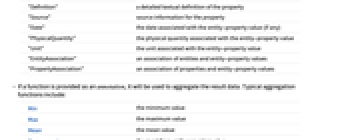-
See Also
- EntityValue
-
- Entity Types
- ZIPCode
-
- Interpreter Types
- ZIPCode
- ComputedZIPCode
-
-
See Also
- EntityValue
-
- Entity Types
- ZIPCode
-
- Interpreter Types
- ZIPCode
- ComputedZIPCode
-
See Also
ZIPCodeData[entity,property]
gives the value of the specified property for the ZIP code entity.
ZIPCodeData[{entity1,entity2,…},property]
gives a list of property values for the specified ZIP code entities.
ZIPCodeData[entity,property,annotation]
gives the specified annotation associated with the given property.


ZIPCodeData
ZIPCodeData[entity,property]
gives the value of the specified property for the ZIP code entity.
ZIPCodeData[{entity1,entity2,…},property]
gives a list of property values for the specified ZIP code entities.
ZIPCodeData[entity,property,annotation]
gives the specified annotation associated with the given property.
Details







- ZIPCodeData[] gives a list of all ZIP code entities.
- ZIPCodeData["Properties"] gives a list of available properties.
- The specified entity in ZIPCodeData can be an Entity, EntityClass, entity canonical name, or list thereof.
- The specified property can be an EntityProperty, EntityPropertyClass, property canonical name, or list of properties.
- Properties that do not apply or are not known in a particular case are indicated by Missing[…].
- Properties include:
-
"AcceptableAddress" acceptable address "ActualAddress" actual address "AggregateHouseholdIncome" aggregate household income "AnnualPayroll" annual payroll "Area" area "AreaCodes" area code "AverageHouseValue" average house value "Businesses" business establishments "BusinessMailboxes" business delivery receptacles "CBSACode" CBSA code "Cities" city "CitySalesTaxRate" city sales tax "ClassificationCode" classification "CongressionalDistrict" congressional district "Counties" counties "CountySalesTaxRate" county sales tax "CSACode" CSA code "Division" census division "Employment" total employment "EmploymentFlag" total employment range "FIPSCode" FIPS code "GenderPopulations" gender populations "GiniIndex" Gini index "HousingUnits" households "LandArea" land area "MedianAge" median age "MedianHouseholdIncome" median household income "Name" name "PerCapitaIncome" per capita income "PersonsPerHousehold" people per household "Polygon" polygon "Population" population "Population15Plus" population ≥ age 15 "Population1Plus" population ≥ age 1 "Population25Plus" population ≥ age 25 "Population3Plus" population ≥ age 3 "Population5Plus" population ≥ age 5 "PopulationDensity" population density "Position" coordinates "PovertyPopulation" population by poverty status "PrimaryCityAliasCode" primary type "PrimaryCityType" primary postal station "PrimaryPlaceName" location "Region" census region "ResidentialMailboxes" residential delivery receptacles "StateAbbreviation" state abbreviation "StateSalesTaxRate" state sales tax "TotalMailboxes" total mail receptacles "TotalSalesTaxRate" total sales tax "UnacceptableAddress" unacceptable address "WaterArea" water area - Some properties are available for ZIPCodeData as a whole and can be given using the form ZIPCodeData[property]. Such properties include:
-
"Entities" all available entities "EntityCount" total number of available entities "Classes" all available entity classes "EntityClassCount" total number of available entity classes "SampleEntities" list of sample entities "SampleEntityClasses" list of sample entity classes "EntityCanonicalNames" list of all entity canonical names "PropertyCanonicalNames" list of all property canonical names "EntityClassCanonicalNames" list of all entity class canonical names "RandomEntities" pseudorandom sample entities {"RandomEntities",n} n pseudorandom entities "RandomEntityClasses" pseudorandom sample entity classes {"RandomEntityClasses",n} n pseudorandom entity classes - The following annotations can be used in the third argument of ZIPCodeData[entity,property,annotation]:
-
"Qualifiers" the list of possible qualifiers for the property "QualifierValues" the list of possible values that can be given to each qualifier "DefaultQualifierValues" the list of default values for the property's qualifiers "Description" a brief textual description of the property "Definition" a detailed textual definition of the property "Source" source information for the property "Date" the date associated with the entity-property value (if any) "PhysicalQuantity" the physical quantity associated with the entity-property value "Unit" the unit associated with the entity-property value "EntityAssociation" an association of entities and entity-property values "PropertyAssociation" an association of properties and entity-property values - If a function is provided as an annotation, it will be used to aggregate the result data. Typical aggregation functions include:
-
Min the minimum value Max the maximum value Mean the mean value Commonest the most frequently occurring value Median the median value Total returns the total Length the number of elements
History
Text
Wolfram Research (2014), ZIPCodeData, Wolfram Language function, https://reference.wolfram.com/language/ref/ZIPCodeData.html.
CMS
Wolfram Language. 2014. "ZIPCodeData." Wolfram Language & System Documentation Center. Wolfram Research. https://reference.wolfram.com/language/ref/ZIPCodeData.html.
APA
Wolfram Language. (2014). ZIPCodeData. Wolfram Language & System Documentation Center. Retrieved from https://reference.wolfram.com/language/ref/ZIPCodeData.html
BibTeX
@misc{reference.wolfram_2025_zipcodedata, author="Wolfram Research", title="{ZIPCodeData}", year="2014", howpublished="\url{https://reference.wolfram.com/language/ref/ZIPCodeData.html}", note=[Accessed: 26-December-2025]}
BibLaTeX
@online{reference.wolfram_2025_zipcodedata, organization={Wolfram Research}, title={ZIPCodeData}, year={2014}, url={https://reference.wolfram.com/language/ref/ZIPCodeData.html}, note=[Accessed: 26-December-2025]}